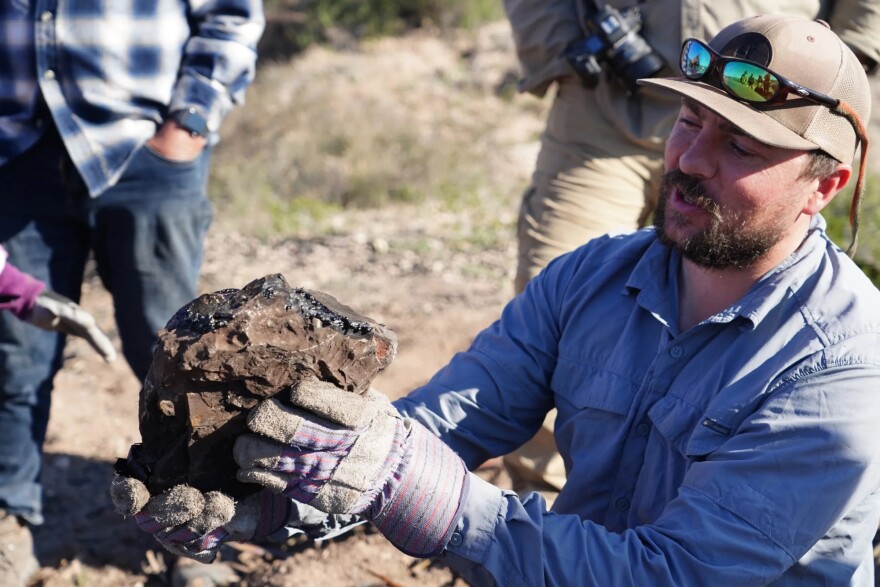Earth ovens — where Indigenous people slow-roasted agaves and other foods — are found by the thousands in West Texas. What accounts for these ubiquitous features? After all, agave-roasting is labor-intensive, and the caloric payoff pales next to hunting a deer. Perhaps ancient people had no choice: As their populations grew, archeologists surmised, they had to work harder to eat.
But maybe economics aren’t the answer. Charles Koenig, an archeologist with Alpine’s Center for Big Bend Studies, has been studying earth ovens, with painstaking analysis and hands-on experiments. Agave-roasting, he argues, was never just about sustenance. It was about celebration, and community.
Koenig will share his agave insights, when Agave Festival Marfa hosts him at the Crowley Theater, June 7 at 2 p.m..
“Indigenous folks have been saying this for decades,” Koenig said, “that it's so much more complicated than just like, ‘Oh, we need to cook these plants to survive.’ It's such a central component of their culture, and it's not about eking something out. It's about thriving in this landscape.”
Agave-roasting is ceremonial in Native communities today. Was that true in the deep past?
Koenig explored that question, as he excavated Eagle Cave, near Langtry. The large cave is packed with the blackened rock left behind by earth-oven cooking.
Koenig developed a careful “rock sorting” technique, which showed there had been thousands of earth-oven firings in the cave, across 10,000 years. But there were also earth-oven “booms,” periods of particularly intensive plant-roasting.
In this canyon near the Rio Grande, one of those booms took place about 5,500 years ago. And Koenig found hints it was about something other than survival.
One clue were the faunal remains. If hunger was driving the agave-baking boom, one would expect meat from larger game to be scarce. But the opposite was true — these Eagle Cave agave-roasters appeared to be feasting.
“That deposit has way more large and medium mammals relative to rabbits than the rest of the deposits,” Koenig said. “That was something that stood out very starkly – is you have fewer rabbits and a lot more medium and large game.”
Distinctive rock art was painted on the cave walls in the same period. And Koenig found many “painted pebbles” – stones adorned with patterns and designs. Such sacred features suggest the agave-roasting may have been part of ceremonial gatherings.
To better understand his subject, Koenig took an unusual step: with help from colleagues, he built earth ovens, and roasted lechuguillas.
Without the benefit of traditional knowledge, it was hit-or-miss. But in one oven, Koenig got it right. After 36 hours of roasting, he opened the pit to find 60 steaming, sweet, carmelized plants.
“This was the first time that any of us had done a real oven,” he said, “in the sense that we loaded it up with a lot of native foods. And to actually see the scale of it was so powerful. This is what it was like for folks for the last 11,000 years, doing this on an annual basis. To see that at scale was really cool.”
Koenig’s experiments showed that the return from earth ovens could be larger than archeologists had believed. And he found that large earth ovens are efficient only when the labor is collective, and coordinated. It’s another sign of the social nature of agave-roasting.
Alcohol has been a lubricant for social gatherings across cultures and times, and Koenig believes fermentation was part of our region’s ancient agave roasts. For now, however, the evidence is elusive.
One thing seems clear — in celebrating the connection between people and plant, Agave Fest is echoing our region’s deepest traditions.
For a schedule of events, visit agavemarfa.com.
Nature Notes is produced by Marfa Public Radio with the Sibley Nature Center. The program can be heard each Tuesday and Thursday, at 7:45 a.m. and 4:44 p.m., Central Standard time, on KRTS Marfa 93.5 FM, and KXWT Odessa/Midland 91.3 FM. This episode was written by Andrew Stuart.




